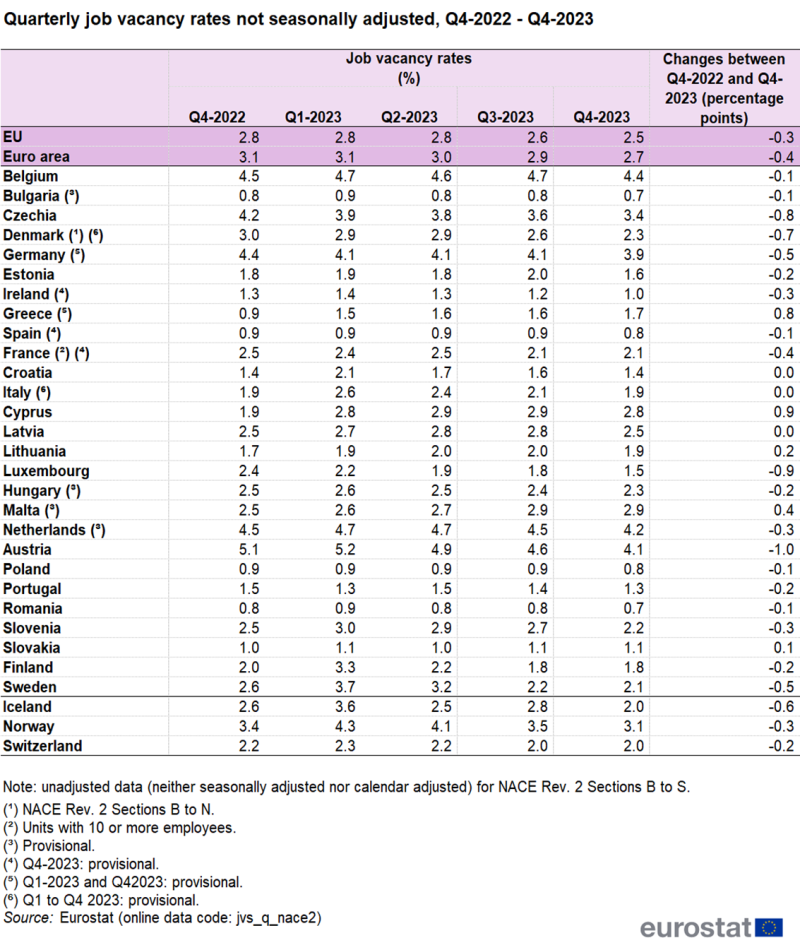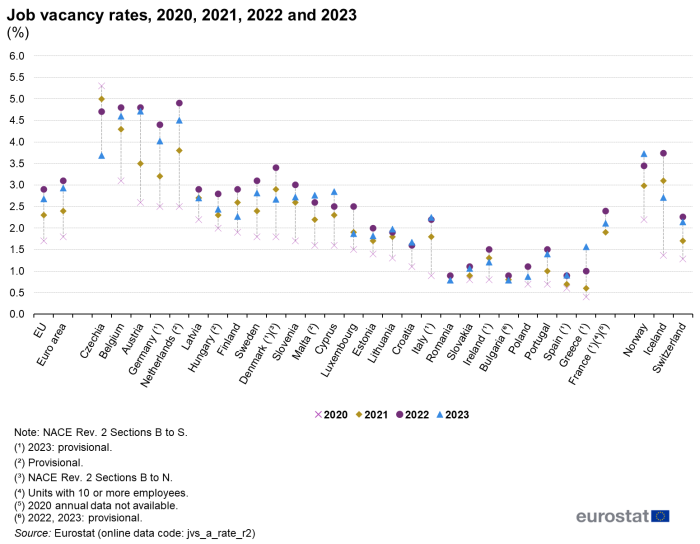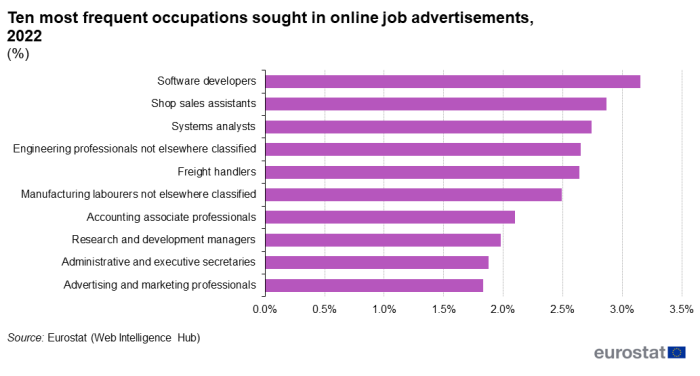Job vacancies: latest developments
The job vacancy rate (not seasonally adjusted) in the euro area[1] was 2.7 % in the fourth quarter of 2023, down from 2.9 % in the previous quarter and 3.1 % in the fourth quarter of 2022. In the EU, the job vacancy rate was 2.5 % in the fourth quarter of 2023, down from 2.6 % in the previous quarter and 2.8 % in the fourth quarter of 2022 as shown in Table 1 and Figure 4.
Source: Eurostat (jvs_q_nace2)
Among EU Member States (see Data sources for information concerning coverage), the highest job vacancy rates in the fourth quarter of 2023 were recorded in Belgium (4.4%), Netherlands (4.2%), Austria (4.1%) and Germany (3.9%). By contrast, the lowest rates were observed in Bulgaria and Romania (0.7% in both of them), Spain and Poland (0.8% in both of them), Ireland (1.0%) and Slovakia (1.1%).
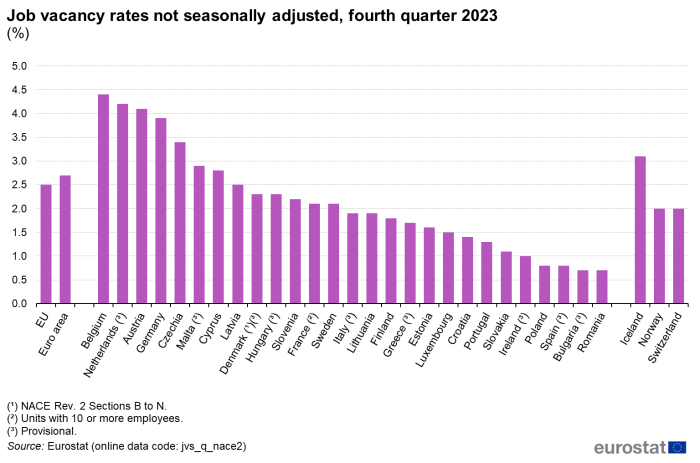
(%)
Source: Eurostat (jvs_q_nace2)
Compared with the same quarter of the previous year, the job vacancy rate increased in 5 EU Member States, remained stable in 3 Member States and decreased in 19 Member States. The largest increases were observed in Cyprus (+0.9 percentage points (pp)), Greece (+0.8 pp) and Malta (+0.4 pp). The largest decreases were recorded in Austria (-1.0 pp), Luxembourg (-0.9 pp) and Czechia (-0.8 pp).
Figure 2 presents information for annual job vacancy rates in 2020, 2021, 2022 and 2023 and displays a pattern of increasing job vacancy rates across all EU Member States in 2021 followed smaller increase in 2022 and drop in 2023.
Job vacancies: a backwards glance
In the EU, the Covid-19 pandemic had an impact on the job vacancy rate recorded in 2020, similar to the economic recession in 2009 (see Figure 3) but with a quicker recovery. At the height of the crisis in 2009, the EU job vacancy rate fell by 0.3 pp compared with the year before, remained unchanged in 2010 before increasing by 0.3 pp in 2011 which offset the impact of the big recession. By comparison, there was a decrease of 0.5 pp in 2020 due to the effects of the Covid-19 pandemic with a subsequent recovery of 0.6 pp in 2021 and 0.6 pp in 2022 whereas the job vacancy rate diminished slightly in 2023 (-0.2 pp).
In the euro area, the Covid-19 pandemic had a more pronounced impact on the job vacancy rate recorded in 2020 than the economic recession in 2009, with a quick recovery in both cases. In 2009, the job vacancy rate of the euro area decreased slightly compared with the year before (by 0.1 pp against 0.3 pp for the EU) and increased back to its initial level in 2010 already. In 2020, the job vacancy rate fell by 0.5 pp with a recovery of 0.6 pp in 2021 and 0.7 pp in 2022 but fell again by 0.2 pp in 2023.
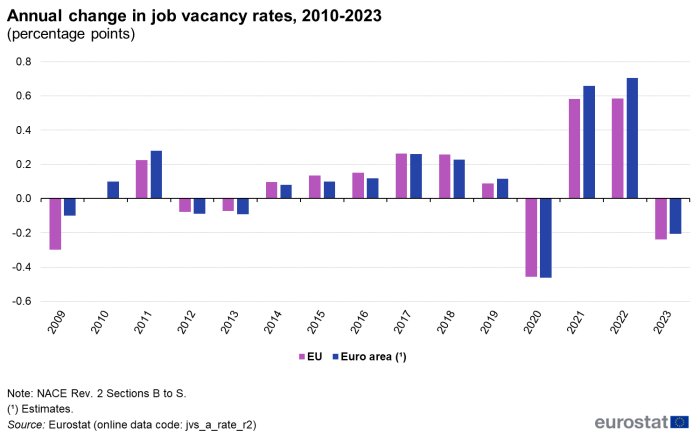
(percentage points)
Source: Eurostat (jvs_a_rate_r2)
Figure 4 presents the development of the seasonally adjusted quarterly job vacancy rates in the EU and the euro area between 2011 and 2023.
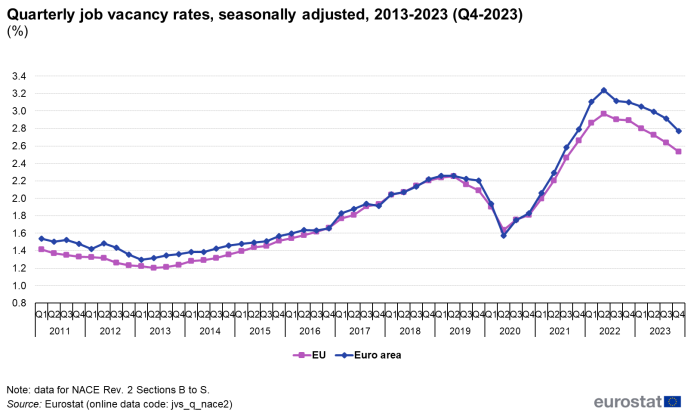
(%)
Source: Eurostat (jvs_q_nace2)
Job vacancies: a breakdown by economic activity
Figure 5 presents the job vacancy rates of the EU and the euro area by economic activity, in the second quarter of 2023. Data are displayed from section B to section N of the NACE Rev. 2 classification, for which data are available from all EU countries. The highest job vacancy rates, for both the EU and the euro area, were recorded in Section N: “Administrative and support service activities” (that includes temporary employment agencies) followed by Section F: “Construction”, Section M: “Professional, scientific and technical activities”, Section J: “Information and communication and Section I: “Accommodation and food service activities”.
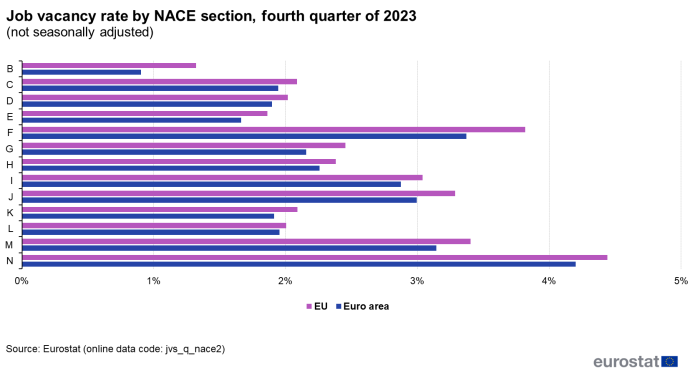
(%)
Source: Eurostat (jvs_q_nace2)
Job vacancies: online job advertisements
The results displayed in this section are collected from a database of online job advertisements, developed by Cedefop and Eurostat. Data are acquired through web scraping, web crawling techniques or direct access using an Application Programming Interface.
The figures refer to reference year 2022. Figure 6 displays the 10 most sought occupations that year, according to the 4th digit level of the ISCO classification, and Figure 7 displays the most demanded skills (in natural language).
Data sources
Eurostat publishes quarterly and annual data on the number of job vacancies and the number of occupied posts. This information is collected on a quarterly basis from the national statistical authorities under the Regulation on quarterly statistics on Community job vacancies. The data may be analysed by economic activity at the NACE section level and by size of enterprise, while data are collected on a voluntary basis by occupation or by region. Annual data for the job vacancy rate are unadjusted information calculated directly from the quarterly data.
Some of the data provided by the EU Member States fail to match common criteria and there may be differences in the coverage between countries. As a result, there are currently no EU totals for the actual numbers of job vacancies or occupied posts, work is currently underway to remove these differences in coverage. Note that the data presented for Denmark relates to NACE Sections B to N, rather than the broader aggregate of NACE Sections B to S used for the other EU Member States. Data for France and Italy refer to enterprises with 10 or more employees, rather than the broader aggregate of all enterprises that is used for the other EU Member States. Due to a methodological change there is a break in series for Malta in 2017. The EU and euro area job vacancy rates are calculated on the basis of the information that is available, no estimates are made for missing or incomplete data.
The source dataset for online job advertisements covers over 100 million ads posted in EU countries, collected from several hundred web sources including job search engines and public employment services’ websites. To the extent possible, automatic systems filter out multiple postings for the same vacancy. Online job advertisements usually include data on the characteristics of the job (e.g., occupation and location), of the employer (e.g. economic activity) and requirements (e.g., education/skills). This information, only available as unstructured data (natural language text), is processed and classified according to main international classifications.
Context
Job vacancy statistics provide information on the level and structure of labour demand. The job vacancy rate may, in part, reflect the unmet demand for labour, as well as potential mismatches between the skills and availability of those who are unemployed and those sought by employers. Job vacancy statistics are used by the European Commission and the European Central Bank (ECB) to analyse and monitor the development of the labour market at national and European level. These statistics are also a key indicator used for an assessment of the business cycle and for a structural analysis of the economy.
Policy developments in this area have focused mainly on trying to improve the labour market by matching supply and demand more closely, through:
- modernising and strengthening labour market institutions, notably employment services;
- removing obstacles to worker mobility across Europe;
- better anticipating skill needs, labour market shortages and bottlenecks;
- improving the adaptability of workers and enterprises so that there is a greater capacity to anticipate, trigger and absorb economic and social change.
The European jobs and mobility portal (EURES) was set-up with the aim of providing job seekers in the EU with the opportunity to consult all job vacancies publicised in each of the EU Member State’s employment services. The website provides access to a range of job vacancies from 31 European countries (27 EU Member States, as well as Iceland, Liechtenstein, Norway and Switzerland). In March 2022, there were almost nearly 4.0 million vacant posts advertised in EURES.
European job days are another EU initiative in this domain, with hundreds of events being organised across Europe. These aim to raise awareness about the opportunities and practicalities of living and working in another European country, encouraging mobility throughout the EU and putting job candidates in touch with employers who have job vacancies. Such events typically include job fairs, seminars, lectures, workshops and cultural events, all aimed at improving labour mobility.

